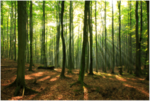The Forest Ecosystem

Related Brandwein Outdoor Learning Activities
All forests tell stories. A snapshot of organisms that live there can reveal a great deal about the events that led to the current ecosystem dynamics. This activity, “An Interview with a Forest,” is designed to give you skills to assess the past history of the forest while looking at its present. Once you’ve completed the activity, you may even be able to predict the future for your local forest using ecological theory.
Trees are the basic structure and function of all forested ecosystems. Trees provide food and shelter to many organisms in their ecosystem as well as provide energy through their biomass (trunks, branches, leaves when they die or drop their leaves each autumn). This activity, “To Know a Tree: Identifying Natural Communities,” allows you to get to know a tree in your local forest and see that a tree is host to many other species and is an “ecosystem onto itself.”
All forest ecosystems change over time. But the introduction of “exotic” species from distant regions to an ecosystem can spark changes that occur so rapidly that ecosystems cannot cope. According to the USDA, “invasive plants are introduced species that can thrive in areas beyond their natural range of dispersal. These plants are characteristically adaptable, aggressive, and have a high reproductive capacity. Their vigor combined with a lack of natural enemies often leads to outbreak populations.” See the activity, “Aliens Among Us: The Effects of Invasive Exotic Plants on Forests.”
